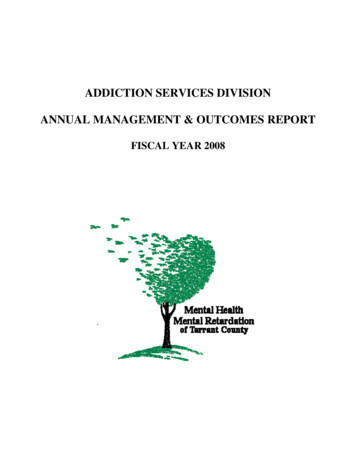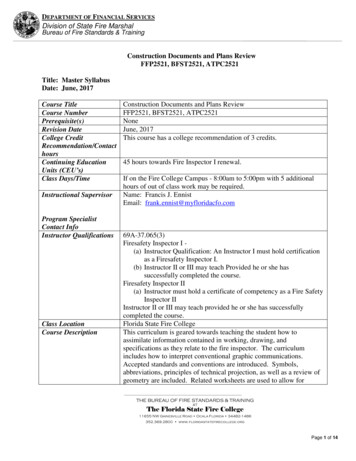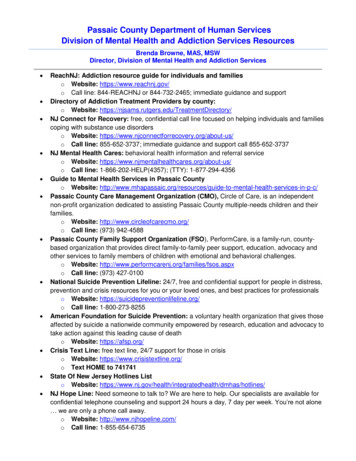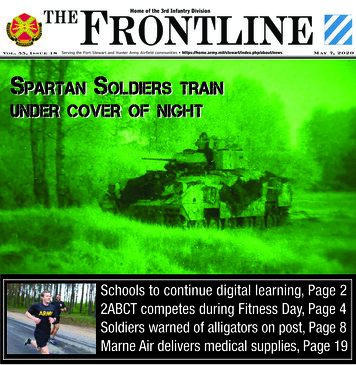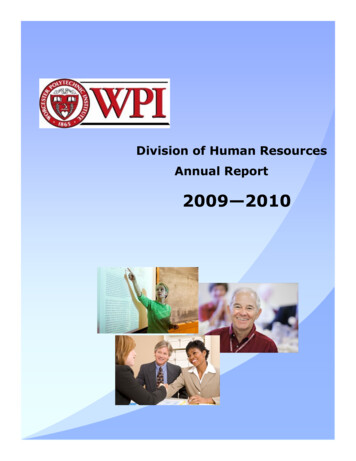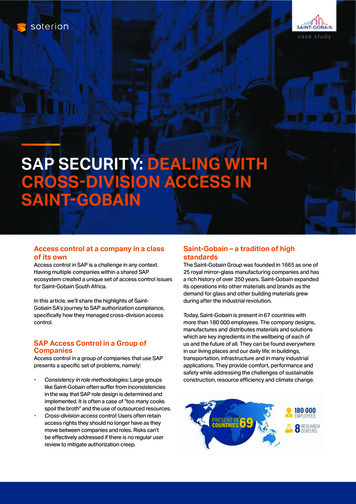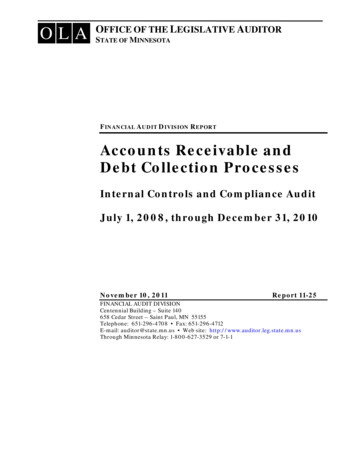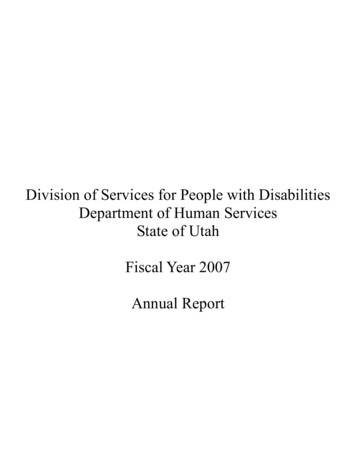
Transcription
Division of Services for People with DisabilitiesDepartment of Human ServicesState of UtahFiscal Year 2007Annual Report
BudgetFor most DSPD consumers, over 70% of their service cost comes from Federal (Medicaid)Funds. As State Funding increases, DSPD is able to serve more families on the waiting list andmaximize Federal funds.Five Year Historic Budget: 200,000,000 178,700,500 180,000,000 160,000,000 147,084,200 153,193,500 159,093,300 165,184,500Budget 140,000,000 120,000,000 100,000,000 80,000,000 60,000,000 40,000,000 20,000,000 2003200420052006Fiscal YearRevenue:Expenditures:2007
Waiting ListEach year roughly 600 people are added to the DSPD waiting list with a critical and immediateneed for services. Unfortunately, some people spend several years on the waiting list beforeDSPD has funds to bring more people into services. Individuals with the most critical need arealways brought off of the waiting list first.Gender Among People onthe Waiting ListPeoplePeople on the Waiting List (5-yr. Historic)FYCurrent Service Needs(18-hr. Care Typically)(6-hr. Care Typically)
Waiting ListGeographic Location of People on the Waiting List
ServicesDSPD provides case management services in the form of support coordination. In addition,DSPD consumers can receive a variety of services from State-contracted providers. Some ofthese services include: Residential Services, Professional Parent/Host Home Services, Assisted/Supervised Living, Respite, Day Training Programs, Supported Employment and more.Common Disabilities Among DSPD Consumers:FY07 New Consumers336 Appropriations24 Emergency15 Portability24 DCFS Agreement399 TotalMild Mental RetardationQuadriplegia, unspecifiedModerate Mental RetardationGeneralized Nonconvulsive EpilepsyHereditary Progressive Muscular DystrophySevere Mental RetardationPrader-Willi SyndromeProfound Mental RetardationAutistic DisorderInfantile Cerebral PalsyInfantile Autism, Current Or Active StateEnrollment (5-YearDown's SyndromeEpilepsyUnspecified Mental RetardationInfantile Cerebral Palsy, UnspecifiedHistoric)Intracranial Injury Of Other And Unspecified NaturePeoplePervasive Developmental DisordersQuadriplegia and QuadriparesisCongenital DiplegiaMultiple SclerosisSpina BifidaOther Conditions Of BrainFYCurrent Service Use(18-hr. Care Typically)(6-hr. Care Typically)
ServicesGeographic Location of People In Services
ProvidersAn important partnership exists between DSPD and the many Home and Community BasedService (HCBS) providers across the state. These private for-profit and non-profit organizations are pivotal in administering DSPD’s program. They provide direct care and supervisionto the people utilizing DSPD services. (Providers are ranked within each grouping so thatthose who serve the most people are at the top of each list.)Serving 500 PeopleAcumen Fiscal Agent, LLCRise IncTurn Community ServicesUtah Transit AuthorityServing 100100-499 PeopleDanville Services CorporationNorth Eastern Services, Inc.Columbus Community CenterWillard G SmithWork Activity CenterKostopulos Dream FoundationFutures Through ChoicesR.I.T.E.S., Inc.Community Oriented Serv For HealingCache Employment & Training CenterTri Connections, Inc.Enable Industries, Inc.Mytrex, Inc. Dba Rescue AlertChrysalis-Ut C/O Carroll & Co.Karen MalmChrysalis Enterprises, Inc.TKJ LLCJordan Valley Supported EmploymentDavis School DistrictServing 5050-99 PeopleServing 1010-24 PeopleCommunity Treatment AlternativesAchieve Community Services, Inc.SL Adovcacy & Community TrainingAvatar IncNorth Eastern Services - LakesUnited Cerebral PalsyWork, Inc.Julie M. BowenAlpine School DistrictPhoenix Services CorporationREM - Utah, Inc.South Valley Training Co.Valley Personnel Services IncProvo School DistrictFront Line Services, Inc.Leonard Consulting, LLCSanpete Community Training CenterDixie Workshop IncKey Residential ServicesQuality Support SolutionsCarefocus, IncUniversity Of Utah UNI HOMEDDI VantageDevelopmental Training SystemsPraxair Healthcare ServicesSalt Lake County Parks And RecCentral Ut Ctr For Ind LivingChoices, Inc.Gerald E. Manwill, Ph.D.KFQ Supports, LlcTri-County Independent LivingPryme CorpLife Skills Vocational CenterTransitions IncActive Re-EntryAscend 2 LLCAlternative Living SolutionsFreewill Foundation IncLife IncludedOptions For IndependenceServing 2525-49 PeopleChoice Supported EmploymentCommunity Careers & SupportMosaicUtah Independent Living CenterLife-Skills & Individl NeedsCarbon County School Dist.Utah State UniversityAffinity Services, Inc.Brain Injury Association Of UTElizabeth AllenMorning Star Financial SrvcsMarylynn HollingsworthJennifer MaughanEnhancing LifestylesI'Connections Sup,Coordination. LLC
Community Supports Waiver (CSW)The Community Supports Waiver provides services for a large majority of DSPD consumers.Children and adults of all ages are served by this waiver. Consumers can choose between awide array of both in-home and out-of-home services.PeopleCSW Enrollment (5-Yr. Historic)According to recent studies, asmany as 5 out of every 1,000Utahns could meet DSPD criteriafor the Community SupportsWaiver.Gender Among CSW ParticipantsFYRaising Awareness:AutismPercent of PeopleThe Center for Disease Control recently published an incidence rate of 7.5 per 1,000 8year old Utahns diagnosed withautism compared to 6.6 nationwide. That study also foundUtah to have the earliest median age for diagnosing autism(4 years 1 month) among participating states.*Age Among CSW ParticipantsAge utismCommunityReport.pdf
Physical Disabilities Waiver (PDW)The Physical Disabilities Waiver provides supports and services to individuals over age 18who have lost the functional use of 2 or more limbs. People who receive supports from thiswaiver utilize the self-administered services (SAS) model to employ 1-2 personal attendantswho assist with activities of daily living.PeoplePDW Enrollment (5-Yr. Historic)FYAge Among PDW ParticipantsPercent of PeopleAccording to recent studies, asmany as 5.75 out of every 1,000Utahns could meet DSPD criteriafor the Physical DisabilitiesWaiver.Age GroupGender Among PDW Participants
Acquired Brain Injury Waiver (ABIW)The Acquired Brain Injury Waiver provides services for people who have experienced lastingimpairments due to a significant, permanent, life-altering injury to the brain. Individuals 18years and older are served by this waiver and may choose from a wide array of services eitherin-home (i.e. supported living ) or out of home (i.e. residential habilitative services).PeopleEnrollment (5-Yr. Historic)FYRaising Awareness:Traumatic Brain InjuryUtah is home to some of the greatest outdoor activities. Unfortunately, each year hundreds ofUtahns are involved in sports-related accidentsand suffer permanent traumatic brain injuries.These injuries can also occur at home. Some simple strategies to prevent brain injury include: Always wear a helmet when using an ATV,motorcycle, snowmobile, bike, skateboard, etc.Always use a seatbelt in an automobileInstall non-slip surface in tub/showerInstall hand rails for aged family membersAge Among ABIW ParticipantsPercent of PeopleAccording to recent studies, as many as1 out of every 1,000 Utahns could meetDSPD criteria for the Acquired BrainAge GroupGender Among ABIW Participants
RegionsDSPD has three regions who perform the tasks of processing intakes, managing the waiting list,and providing services in the form of case management/support coordination statewide. The regions are pivotal in administering the Community Supports and Acquired Brain Injury Waivers.Northern: John Schoenfeld, Director6 Supervisors, 54 Caseworkers, 6 Offices, 1,195 Consumers at year end This fall the region participated as one of the initial sites for the family preservation pilot project. The group included families from both Box Elder and Cache counties. Deb O'Dell along with some of her staff participated inthis endeavor. The families received respite care as well as counseling and other related services. Leslie Howell and some of her staff provided training to the Crisis Intervention Team Academy for police and corrections staff. The training was designed to educate first responders about the problems and issues faced by peoplewith disabilities and their families. Northern region has continued to participate in the Supported Employment pilot project this year. We have beenworking to improve and expand service brokering to the Brigham and Logan offices. We are also working withLinda Shaffer, who is the new supervisor, in the Salt Lake office to improve brokering services in this area of theregion.Central: Melody Morgan, Director9 Supervisors, 69 Caseworkers, 4 Offices, 1,752 Consumers at year end In FY07 Central Region piloted three after school programs for children to help prevent out-of-home/residentialplacements. The success of this program led to the utilization of a new service code statewide. This year, Central region worked with a provider to develop a mobile food service cart staffed by DSPD consumersin Vernal/Roosevelt serving local businesses. The project has been successful in providing work opportunities forindividuals living in an area that has at times lacked employment opportunities for people with disabilities. Central Region continues to improve the community service brokering program which helps DSPD consumers onthe waiting list access other state and federal supports and services. In FY07, Central Region provided support to291 people on the waiting list.Southern: Susan Macnamara, Director8 Supervisors, 62 Caseworkers, 13 Offices, 1,477 Consumers at year end This year we piloted USTEPS in two offices (Price, Cedar City) with very positive results. The USTEPS team learned alot about what they needed to do to make the program truly useful and staff learned how to use the new system. Southern Region continues with Region Quarterly Newsletter that shares important information about changes in theRegion, introduces new staff, and recognizes the positive contributions across the whole range of workers in theRegion. The Region was able to expand services to those living on the Navajo reservation by the creation of two day programs, one in Montezuma Creek and the other in Monument Valley. Without these programs these individuals wouldbe unable to participate in programs designed to improve community living skills.
Self-Administered Services ModelThe Self-Administered Services Model allows families to act as the employer of record in providing services to the DSPD consumer. Families manage paperwork, submit time cards forhired staff, and monitor finances. This allows the family to choose the best staff for their family member and typically results in lower service costs.Utilization of SAS vs. Provider ModelAvailable Services SAS ModelOnlyProviderModel OnlyBoth Models735 People3,203 People736 People15.7% 68.5%15.7% PeopleUse of SAS-Model 5-Year HistoricRespitePersonal AttendantsSupported eristics of PeopleUtilizing the SAS-Model*Number of years using SAS modelYearsPercent GraphLess than16.5% 111.3% 28.8% 36.8% 47.4% 512.2% 625.5% 77.6% 8 13.9% FYStateState-ContractedFiscal InyermediariesAcumen Fiscal AgentLeonard ConsultingMorning Star Fiscal AgentNumber of current employeesEmployeesPercent Graph04.0% 129.4% 228.0% 315.3% 412.1% 55.4% 6 5.9% * Based on an annual survey conducted by mail whichyielded roughly 350 responses.
Supported Employment PilotHouse Bill 31 was signed into law by Governor Huntsman in March 2006. In the first year ofthe pilot program, DSPD, in partnership with the Office of Rehabilitative Services, received 150,000 to provide supported employment services for 100 people on the DSPD waiting list.This program has been successful by giving supports to people who might still be on the waitinglist for supported employment without the pilot’s intervention.Supported Employment Waiting List (5-Year Historic)PeopleEach monthroughly 11 peopleare added to theDSPD waitinglist for supportedemployment.The SupportedEmployment Pilot has helpedoffset these additions.MonthJosh is a young man who is deafand has mild developmental disabilities. After graduating, hereally wanted to start working.Thanks to the pilot, he was ableto receive a job coach fluent insign language. With the help ofhis job coach, Joshlanded a full-time benefited position at WalMart. His job coach reports that Josh gets alongreally well with the otherdock loaders/unloaders,and he was teaching themsign language. WhenJosh completed his hourswith VR, he didn't feellike he needed the jobcoach any more. Hesaid, "Someone elsecould use more help than me."Josh's example is just one of manyemployment success stories whichhas helped reduce DSPD's supported employment waiting list.End of Year Stats: 105 participants5 successful closures59 employment successstoriesAvg Wage: 6.87 perhourAvg Hours: 21 per week
Mytrex, Inc. Dba Rescue Alert Chrysalis-Ut C/O Carroll & Co. Karen Malm Chrysalis Enterprises, Inc. TKJ LLC Jordan Valley Supported Employment Davis School District Serving 50Serving 50- ---99 People99 People Community Treatment Alternatives Achieve Community Services, Inc. SL Adovcacy & Community Training Avatar Inc




